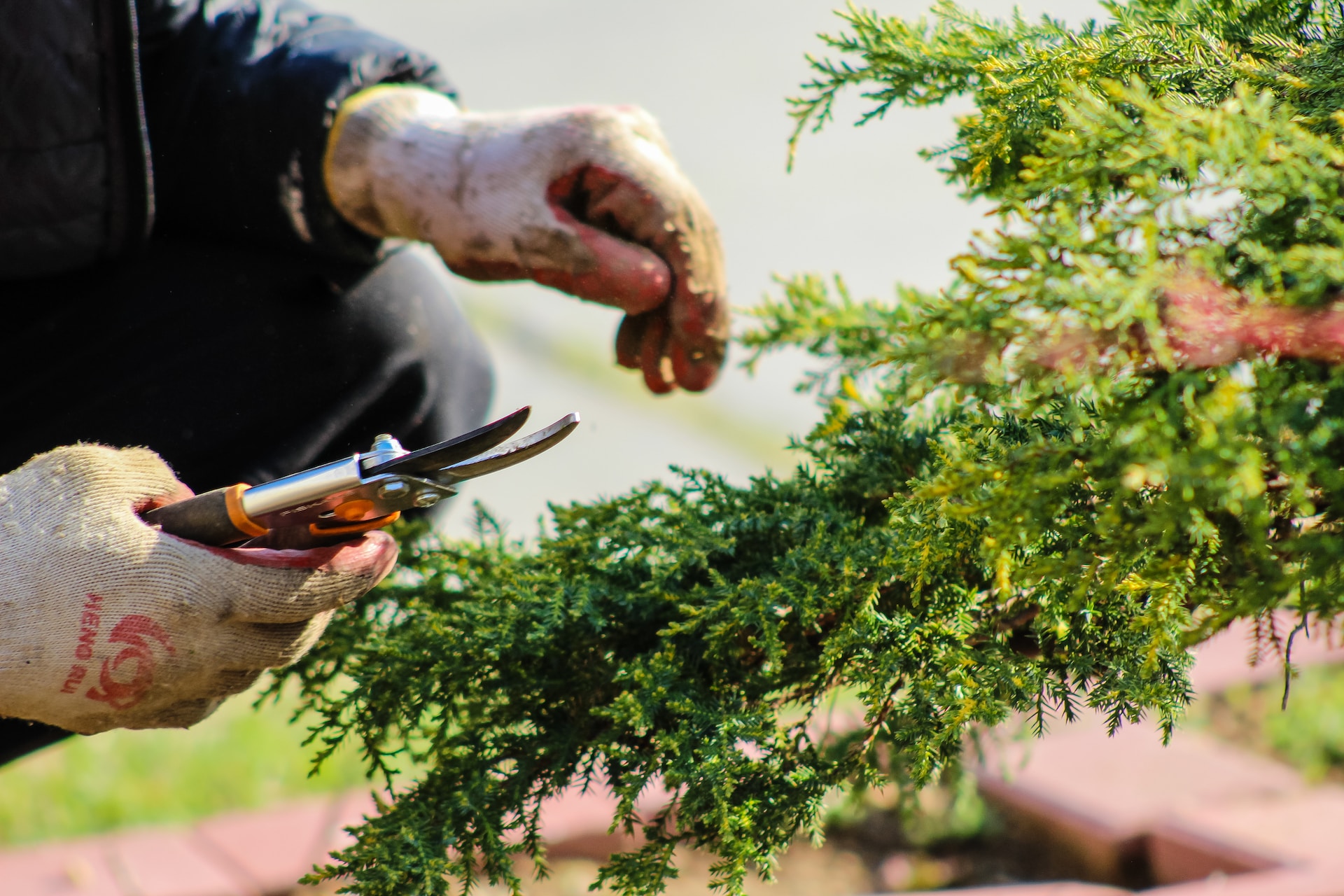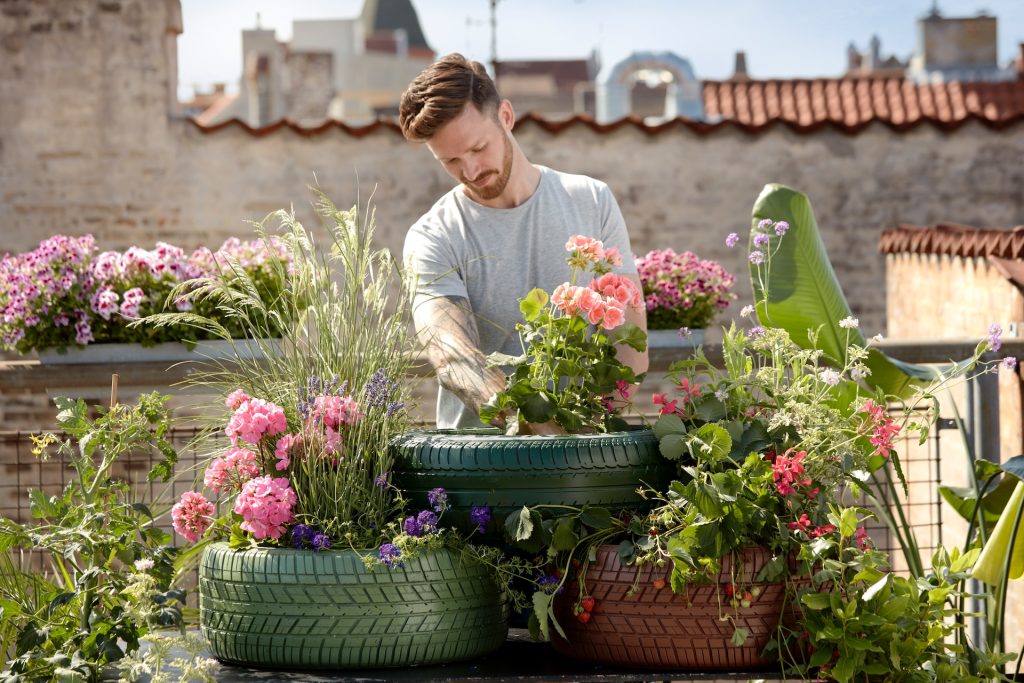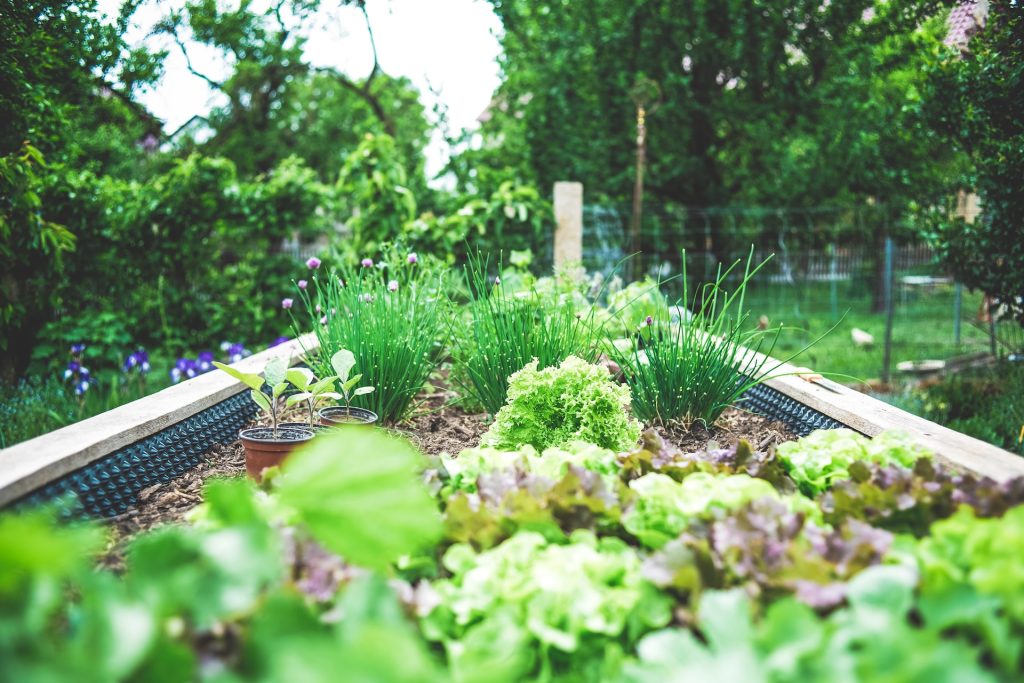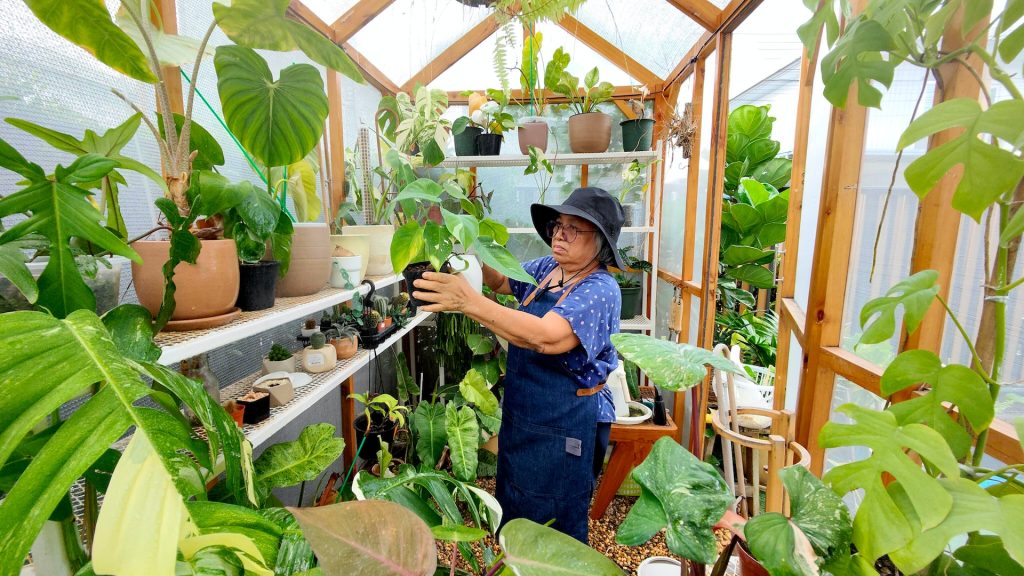Home Decor
Seasonal Gardening In Glasgow: Making the Most of Each Season’s Produce and Blooms

Glasgow, nestled amidst Scotland’s lush landscapes, stands as a testament to the harmonious blend of urban life with nature. Gardening in this temperate maritime haven is both a challenge and a reward, given its distinct seasonal transitions. Seasonal gardening, when approached with knowledge and passion, not only enriches the biodiversity of Glasgow but also transforms the cityscape with year-round visual delights.
Embracing the cyclical rhythm of nature, understanding the local soil, and anticipating the climatic intricacies can result in a garden that’s a veritable feast for the senses, regardless of the season.
Seasonal Gardening In Glasgow in Winter: Dormant Beauty and Early Blooms

While many perceive winter as a time of dormancy in the garden, it is, in fact, a season of underlying vibrancy and preparation. The seemingly barren landscapes lay the canvas for early bloomers and set the stage for the gardening year ahead.
1. Preparing the Soil
In Glasgow’s crisp winter months, the garden’s soil, devoid of its usual hustle of growth, offers an opportune moment for rejuvenation. Enriching the earth now ensures a fertile foundation for the coming seasons. By incorporating well-rotted compost or aged manure, gardeners reintroduce vital nutrients and beneficial microorganisms into the soil. This organic matter not only improves soil structure, promoting better drainage and aeration but also serves as a reservoir of slow-release nutrients, paving the way for robust spring growth.
2. Winter Plants
Even in the chill of winter, some plants defy the odds, piercing through the frost with their blooms. Winter jasmine, with its delicate yellow flowers, is a beacon of hope amidst the grey, while the pristine white of snowdrops offers a contrast to the barren earth. Another gem for winter gardens in Glasgow is the Hellebore, often dubbed the ‘Christmas Rose’. Hellebores showcase a range of subtle colors and patterns, proving that even in the coldest of months, nature has its artistry on display. These plants are not just aesthetic delights; they’re also vital sources of nectar for any brave pollinators venturing out in the cold.
3. Protection
Winter’s beauty comes with its challenges. Glasgow’s harsh frosts can be detrimental to tender plants, especially evergreens that retain their foliage and young plants that haven’t yet established robust root systems. Protective measures become paramount. Horticultural fleece acts as a barrier, trapping heat and ensuring that the cold doesn’t penetrate the plants beneath. Similarly, mulching with organic materials like straw or leaves provides an insulating layer for plant roots, shielding them from temperature fluctuations and retaining essential soil moisture. Beyond just physical protection, these measures also bolster the soil’s health, ensuring that when spring arrives, the garden is primed for growth.
4. Pruning and Shaping
Pruning is an art and science, essential not just for aesthetics but for the health and vigour of many plants. During winter, deciduous trees and shrubs shed their leaves, revealing their skeletal structure. This leafless state provides gardeners with a clear view, making it easier to identify and remove dead or diseased branches. Pruning during the winter dormancy reduces the stress on plants, allowing them to direct their energy towards new growth come spring. Furthermore, cutting back in the cooler months reduces the risk of disease transmission, as many pathogens are less active. Thus, a well-pruned garden in Glasgow’s winter sets the stage for a lush, disease-free spring.
5. Bird Feeders
Winter’s embrace can be harsh on local bird populations, with natural food sources dwindling. By setting up bird feeders, gardeners offer a lifeline to these feathery friends. The sights and sounds of finches, robins, and other local birds flitting about can enliven even the dreariest winter days. Using a mix of seeds, nuts, and fat balls caters to a variety of bird species. Moreover, birds play a pivotal role in pest control and pollination. Thus, by nourishing them in winter, gardeners foster a symbiotic relationship that reaps rewards in the warmer months.
6. Planning Ahead
Winter’s stillness offers a reflective pause in the gardener’s calendar. With reduced hands-on tasks, it’s the perfect time for research and planning. Gardeners can delve into horticultural literature, explore new plant varieties suited to Glasgow’s climate, or perhaps sketch out new design layouts. Winter might also be the time to ponder larger projects: a new garden shed, pathways, or raised beds. By utilizing this downtime for meticulous planning, gardeners ensure that when the growing season commences, they’re equipped with a clear vision and actionable blueprint.
7. Water Features
While the thought of water in Glasgow’s frosty winters might evoke images of frozen ponds, modern garden features can defy these icy odds. Heated birdbaths, for instance, provide birds with a consistent water source, vital for both drinking and feather maintenance. Similarly, a gently bubbling fountain, resistant to freezing due to its movement, can introduce a mesmerizing focal point. The interplay of light on water, coupled with the soft gurgling sounds, can transform a garden into a winter wonderland, offering solace and tranquillity amidst the cold.
Glasgow’s Seasonal Gardening In Spring: Burst of Colors and New Beginnings

As Glasgow sheds its winter cloak, the city blossoms into a symphony of colors and renewed vitality. Spring signifies a time of rebirth, where dormant gardens awaken, surging with life and promise. The sun, taking a higher arc in the sky, extends its warming embrace, invigorating the soil and coaxing the first buds to unfurl. Songbirds return with melodies, and everywhere, there’s a palpable sense of anticipation. For gardeners, spring is not just a season; it’s an emotion, a call to action, an invitation to witness and partake in nature’s grand resurrection.
1. Spring Bulbs
Autumn’s foresight translates into spring’s spectacle when bulbs burst forth in a dazzling display. Daffodils, with their trumpeted blooms, announce the season’s arrival, followed closely by tulips in a spectrum of hues, from deep purples to vibrant reds. Crocuses, often among the earliest to show, pepper the ground with their delicate petals. In Glasgow, where winters can linger, these bulbous plants offer the first vibrant affirmation of the impending warmer days. Their resilience and beauty serve as a testament to nature’s cyclic rhythm and the wonders of underground life ready to emerge.
2. Vegetables to Plant
With the ground slowly shedding its winter chill, garden beds beckon for a new cohort of crops. Potatoes, those underground gems, can be sown now, anticipating a hearty harvest. Lettuce, with its quick growth cycle, promises fresh salads in a matter of weeks. Peas, climbing gracefully, bring both visual appeal and the promise of sweet, crunchy pods. In the sheltered confines of a Glasgow home, tomatoes and peppers can start their journey, protected from any lingering frosts. Once these seedlings gain strength, transplanting them outdoors paves the way for a summer bounty.
3. Pest Watch
But spring’s warmth, while a boon for plants, also stirs unwanted garden guests. Aphids, slugs, and other pests emerge, eager to feast on fresh foliage. Vigilance becomes a gardener’s ally. Regularly inspecting plants, turning leaves, and checking stems can catch infestations early. In keeping with nature’s balance, ladybugs can be introduced as they’re voracious aphid predators. Neem oil, a natural derivative, acts as both a repellent and pest deterrent. Embracing such eco-friendly solutions ensures a garden thrives without compromising its delicate ecosystem.
4. Lawn Care
Come spring, the lawns of Glasgow once again demand attention. As the grass rejuvenates, regular mowing ensures it remains lush and even. However, the eagerness to achieve a pristine lawn must be tempered with caution. Cutting the grass too short can expose it to drought stress and allow for weed invasion. Aeration, especially in areas with heavy foot traffic, allows the soil to breathe, facilitating better nutrient absorption. Compacted soils can stifle root growth, making aeration a critical spring task. Alongside, a gentle application of spring-specific fertilizer provides the grass with essential nutrients, encouraging verdant growth and resilience against pests.
5. Protect Against Late Frosts
Spring’s charm lies in its unpredictability. Yet, this capricious nature can also be a gardener’s bane in Glasgow. While days might shimmer in warmth, nights can still carry the bite of frost. Tender plants, especially those newly sprouted or transplanted, remain vulnerable. Employing cloches—bell-shaped glass or plastic covers—can offer a microclimate, shielding plants from the cold. For larger areas or rows, frost cloth or horticultural fleece serves as a protective blanket, warding off the chill and ensuring the garden’s tender inhabitants survive to see summer.
6. Staking and Support
Perennials, with their promise of recurring blooms, embark on their upward journey in spring. As they gain height, some, especially those with large flower heads or slender stems, can become top-heavy. Staking early, while they’re still manageable, ensures they grow upright, free from the risk of snapping or drooping under their weight. Using bamboo sticks, metal supports, or even netting can offer the requisite structure, guiding plants gracefully skyward. In the process, gardeners not only ensure plant health but also curate an aesthetically pleasing garden tableau.
7. Garden Clean-Up
Spring heralds a fresh start, and nothing facilitates growth better than a clean garden. Any remnants of autumn—a stray leaf pile, decayed fruits, or other debris—can harbor pests or diseases. Clearing these ensures plants aren’t stifled and have unhindered access to sunlight and air. Additionally, a tidy garden reduces the risk of fungal infections, which often thrive in damp, cluttered environments. Beyond the practical, a clean garden exudes an aura of care and preparation, signaling readiness for the crescendo of colors and life that summer will bring.
Seasonal Gardening In Summer in Glasgow: Lush Vegetation and Vibrant Blooms

Summer in Glasgow is nothing short of a botanical ballet, with the landscape transforming into a vibrant tapestry of colors and textures. As the days stretch and temperatures rise, gardens respond with a crescendo of life. Sun-drenched beds teem with blossoms, while vegetable patches promise the fruits of meticulous springtime labors. It’s a season where the garden becomes not just a space of cultivation but a sanctuary of beauty and nourishment.
1. Summer Blooming Plants
Summer’s palette in Glasgow is enriched by the presence of iconic bloomers. Roses, the eternal symbols of love and beauty, unfurl their petals in a myriad of hues, from the deepest reds to the most delicate pinks. Lavender, with its slender, fragrant spikes, dances in the breeze, offering not just visual delight but a sensory experience. Geraniums, whether in containers or borders, punctuate the green with their vivid flowers, exuding a timeless summer charm. These plants, nurtured by the Glasgow sun, serve as the backbone of many a summer garden, weaving tales of romance, nostalgia, and sheer splendor.
2. Harvest Time
As summer progresses, vegetable patches turn into treasure troves. Beans, dangling like green jewels, beckon to be plucked. Carrots, their leafy tops hinting at the orange-gold beneath, await harvest. Zucchinis, with their rapid growth, can almost be seen swelling by the hour. In Glasgow’s summer, the act of harvesting becomes a ritual of gratitude. Regularly picking these veggies not only offers fresh, organic produce for the table but also encourages plants to keep producing, ensuring a continuous bounty through the season.
3. Watering and Feeding
The Scottish sun, though not as relentless as in some parts of the world, still brings about longer days and increased evaporation. Plants, in their peak growth phase, have an amplified thirst. Watering, preferably during the early morning or late evening when the sun’s rays are less intense, ensures that plants receive the moisture they need without the risk of scorched leaves. Flowering plants, now in their prime, benefit from potassium-rich fertilizers, which bolster their blooming capabilities, ensuring that Glasgow’s summer gardens remain a riot of colors and fragrances until autumn’s first whisper.
4. Deadheading
In the heart of Glasgow’s summer, plants unfurl their blossoms in a vivid display. However, as the petals begin to wilt and fade, they not only mar the beauty of the plant but can divert energy from new growth. Deadheading, the process of removing these spent blooms, serves multiple purposes. Beyond aesthetic appeal, this practice ensures that plants don’t waste energy on seed production, especially in ornamental varieties where seed propagation isn’t desired. For many species, such as roses and geraniums, deadheading can coax out a second, albeit smaller, wave of flowers, extending the bloom period and ensuring continuous vibrancy.
5. Pond Care
Garden ponds, a haven for wildlife and a tranquil feature in many Glasgow gardens require summer attention. Algae, especially in sun-drenched ponds, can proliferate rapidly, suffocating aquatic life and turning clear waters murky. Manual removal, along with introducing algae-eating fish or using environmentally friendly treatments, can restore balance. Summer’s evaporation might reduce water levels, so regular top-ups with rainwater (or dechlorinated tap water) are essential. Monitoring aquatic plants, ensuring they’re not overcrowded and remain vibrant, guarantees the pond remains a thriving ecosystem.
6. Shade Solutions
Glasgow’s summer sun, while not as blistering as in some global regions, can still pose a threat to sensitive plants. Foliage might wilt or scorch, and young plants risk stunted growth. Offering respite through shading becomes pivotal. Pergolas, wooden or metal structures adorned with climbers, filter the sun, casting dappled light below. Awnings, and retractable fabric canopies, offer instant shade for patios or decks. For vegetable patches or flower beds, shade cloths—mesh-like fabrics that cut out a percentage of sunlight—can shield plants during heatwaves, ensuring they continue their summer growth unimpeded.
7. Continuous Planting
For avid gardeners and those keen on self-sufficiency, a steady flow of produce is the summer dream. Succession planting is the answer. By staggering plantings of fast-growing crops like lettuce, radishes, or beans, one can ensure that as one batch is harvested, another is maturing. This methodical approach guarantees that Glasgow Gardens offer not just a seasonal feast but a continuous one, marrying the joy of gardening with the delight of farm-fresh produce.
Seasonal Gardening In Glasgow in Autumn: Preparations and Planting for the Future

As Glasgow’s vibrant summer gives way to the gentle embrace of autumn, gardens enter a phase of transition. The fiery hues of falling leaves contrast with the crisp air, signaling a period of rest and rejuvenation. While the crescendo of summer blooms might be a memory, autumn is not just an end but a promise of new beginnings. Gardening tasks are important from maintenance and harvest to preparation and foresight.
1. Planting for Spring
Autumn in Glasgow is characterized by the soil still retaining warmth, even as the air cools. This creates an ideal environment for planting spring bulbs such as tulips, daffodils, and hyacinths. By burying these pockets of potential beneath the earth, gardeners invest in the spectacle of spring’s rebirth. Additionally, perennials like rudbeckia and echinacea can be introduced to the garden landscape. Their hardy nature allows them to send down roots in preparation for the winter chill, ensuring a robust growth spurt when spring arrives.
2. Harvesting Root Vegetables
Beneath the soil’s surface, autumn offers a bounty. Root vegetables, having absorbed nutrients throughout the summer, are now ripe for harvest. Turnips, with their crisp texture, parsnips, which become increasingly sweet as the temperature drops, and beetroot, a jewel of the earth, await the gardener’s hand. Some vegetables, notably carrots, undergo a transformation after a frost. The cold converts their starches to sugars, resulting in a sweeter, more flavorful crop, making the first frost in Glasgow a much-anticipated event for vegetable enthusiasts.
3. Composting
Autumn is a season of abundance but also of decay. Leaves, once a verdant canopy, cascade down, and plants retreat inwards. However, in this seeming decline lies the promise of future fertility. Starting a compost pile in autumn is a garden’s way of capturing this ephemeral essence. By layering leaves, plant debris, and organic kitchen waste, one initiates a cycle of decomposition. Over months, these materials break down, aided by microorganisms and worms, to form compost. This rich, dark substance, teeming with nutrients, will nourish Glasgow’s gardens in the coming year, ensuring the cycle of life continues unabated.
4. Leaf Mulch
As the trees in Glasgow shed their autumnal cloak, a golden opportunity arises for gardeners. Collecting these fallen leaves, instead of discarding them, can lead to the creation of leaf mulch—a gardener’s treasure. When piled and allowed to decompose, these leaves break down into a dark, crumbly, nutrient-rich substance. Spreading this over garden beds acts as a protective layer, conserving moisture and warding off weeds. More than just a barrier, it gradually decomposes, enriching the soil with organic matter and ensuring plants in Glasgow benefit from improved soil health and structure.
5. Greenhouse Preparation
For those fortunate enough to have a greenhouse or cold frame, autumn signals preparation time. With winter’s chill on the horizon, these structures become vital in sheltering tender plants and providing a controlled environment for seed germination. But before they play this role, it’s crucial to give them a thorough clean. Eliminating any lurking pests or diseases ensures a healthy start for overwintering plants. Moreover, sanitizing pots, trays, and surfaces can set the stage for a successful early start to next year’s growing season.
6. Lawn Maintenance
While lawns might seem resilient, the rigors of winter can test their endurance. Autumn lawn care in Glasgow is thus centered around fortifying these green expanses. Applying a specially formulated autumn lawn feed, rich in potassium and phosphorus, can strengthen grassroots against the cold and damp. This nutrition also aids in resistance to diseases and moss. If the summer has left bald patches or areas of wear, autumn is an apt time for repair. Sowing grass seed and ensuring consistent moisture can rejuvenate these spots, making sure the lawn remains a lush carpet.
7. Plant Spring-Flowering Bulbs
The magic of spring in Glasgow is often heralded by the iconic blooms of daffodils and tulips. But the bulbous realm offers so much more. Planting diverse bulbs like the spherical blossoms of alliums or the delicate bells of fritillaries can elevate a garden’s spring display. These bulbs, often overlooked, can provide unique shapes, colors, and textures. Nestled in the autumn soil, they await their turn, promising a vibrant tableau when winter’s grip loosens.
Conclusion
As the four seasons ebb and flow, Glasgow’s gardens can truly reflect the city’s vibrant spirit, historical heritage, and deep-rooted connection with nature. Seasonal gardening isn’t merely about planting seeds or harvesting produce; it’s a dance with time, an understanding of ecological balance, and a celebration of life’s cyclical beauty. By intertwining traditional gardening wisdom with modern horticultural practices, Glaswegians can cultivate spaces that not only enhance biodiversity but also promote sustainable and organic urban living. Whether you’re a novice gardener or a seasoned expert, Glasgow’s ever-changing canvas of flora offers endless opportunities to learn, grow, and flourish. Embrace each season, and let your garden tell its unique story throughout the year.
FAQs
Seasonal gardening in Glasgow refers to gardening practices tailored to the city’s distinct seasons. It emphasizes optimizing plant growth, maintenance, and harvest according to the unique conditions of each season, ensuring gardens remain vibrant throughout the year.
Leaf mulch is vital because it conserves soil moisture, deters weeds, and improves soil health. In Glasgow’s autumn, fallen leaves can be collected and decomposed into a nutrient-rich mulch, providing organic matter and enhancing soil structure.
Preparing a greenhouse for winter involves a thorough cleaning to eliminate pests and diseases. Sanitizing pots, trays, and surfaces ensures a healthy environment for overwintering plants or an early start to the next growing season.
In Glasgow, autumn lawn maintenance includes applying an autumn-specific lawn feed to strengthen grassroots. Repairing bald patches or areas of wear, either by sowing grass seed or ensuring consistent moisture, ensures a lush lawn even in winter.
While daffodils and tulips are popular choices, diversifying with bulbs like alliums and fritillaries can elevate a garden’s spring display. Planting these in autumn ensures a colorful and varied tableau come springtime.
Composting recycles plant debris and organic waste, converting it into nutrient-rich compost. In Glasgow, starting a compost pile in autumn captures the essence of decay, which when decomposed, nourishes the garden, promoting plant health and soil fertility.
In Glasgow’s summer, watering plants during cooler hours reduces evaporation. Additionally, using potassium-rich fertilizers sustains flowering plants’ blooms and ensures their vibrant display throughout the season.
Spring’s warmth in Glasgow can invite pests. Regular monitoring and employing natural methods, like introducing ladybugs or using neem oil sprays, can effectively keep unwanted critters at bay and protect plants.
Autumn planting allows spring bulbs and certain perennials to establish roots before winter. By doing so, they’re better prepared for a robust growth spurt in spring, ensuring a vibrant display when the season arrives.
Natural methods such as introducing beneficial insects (like ladybugs), using neem oil, or employing barriers and traps can be effective. Additionally, practicing crop rotation and companion planting can deter pests in a more organic way.

Home Decor
Airport Wellness Corners Where Fitness Equipment Movers Los Angeles Keep Shift Changes Smooth

Airports run on clockwork and caffeine, so tiny wellness corners can feel like secret cheat codes for tired shoulders. When a shift flips, bodies do not magically reset, so a few smart stations with bikes, stretch tools, and compact strength gear can help. Midway through the plan sits this link as a practical reference https://beezeemovers.com/fitness-equipment-movers-in-los-angeles and it points to the kind of specialized handling that keeps schedules intact. The goal is simple: calm set ups, fast swaps, and spaces that feel welcoming, not like a loud showroom. It also helps to treat the corner like a lounge, not a punishment for skipping leg day. A card with three quick moves and a timer helps, so it stays easy at 5 a m. Even a small fan and calming scent can shift the mood.
How Can A Terminal Make Recovery Feel Effortless
Think of it like adding a pit stop to a long race, except nobody is wearing a bib and the finish line keeps moving. A narrow break room can still host a foldable bike, resistance bands, and a mat that does not slide, as long as access paths stay clear and noise stays low. Placement matters, too, as staff will use what they can reach without negotiating carts, doors, and security lanes. A simple rule works: if it takes more than a minute to start, it will collect dust. If the space sits near a break table, even better. People will stretch while coffee cools. And if the gear looks clean and simple, it feels safe to touch, and that matters.
The Quiet Logistics Behind The Curtain
Moving heavy gym gear through secure corridors is less about brute force and more about etiquette. Routes are timed around cleaning windows, baggage surges, and that brief calm when a gate finally exhales. Protective wraps, floor runners, and clean gloves keep the vibe professional, and the result is a set up that feels almost invisible.
- Schedule roll ins between flights and shift peaks.
- Use soft wheels that respect polished terminal floors.
- Keep fasteners bagged and labeled for quick reassembly.
- Test clearances for doors, ramps, and tight turns.
After the gear lands, a quick wipe down and a sanity check on bolts keeps everything ready for real use, not just photos.
What Makes These Micro Gyms Actually Get Used
It is not the fanciest machine, it is the feeling. Staff lean into stations that offer relief without asking for a full outfit change or a thirty-minute commitment. Add signage that reads like a friendly nudge, not a lecture, and suddenly the corner becomes part of the routine. Even better, rotate one small item monthly so the space stays fresh without becoming clutter. One more trick is lighting. Harsh fluorescents make everything feel like an inspection, while warmer bulbs make the corner feel like permission. Add a small hook for lanyards and keys, and the experience stops being awkward.
Shift Changes End With Less Ache And More Air
When the swap happens, the room should invite a reset in the same way a good playlist smooths a long drive. A couple of minutes on a compact cardio unit, a stretch sequence, and a sip of water can turn grumpy fatigue into workable calm. And because airports never sleep, the best layouts favor low sound, clean lines, and quick shutdowns so the next crew inherits a space that feels so cared for. Done right, the corner becomes a morale boost that travels crew to crew. It does not replace sleep, but it can save the last hour of a shift from feeling endless. That is the quiet win: a healthier handoff, done with respect for time and bodies.
Home Decor
Keep the Heat On: Why November Is the Smartest Month for Boiler and Heating Checks

As the nights draw in and the temperature drops, it’s officially boiler season. November is when many households across the UK switch their heating back on for the first time in months and realise something’s not quite right. Maybe the radiators are slow to heat up, the water’s lukewarm, or the boiler makes a strange noise.
That’s exactly why November is the best time to arrange a boiler service and make sure your heating and hot water system is ready for winter. A quick check now can prevent breakdowns, improve efficiency, and keep your home warm when you need it most.
Why November Is the Perfect Month to Book
1. The Weather’s Cool but Not Freezing Yet
November sits in that ideal middle ground between mild autumn and freezing winter. Engineers tend to be easier to book, and you can have your system checked before demand peaks. Once December hits, call-outs start to surge, and getting an appointment can take longer. Taking care of it now means you’ll be prepared for the colder weather ahead.
2. Catch Problems Early
During summer, your boiler spends months barely ticking over, providing only hot water. That downtime might seem harmless, but it can allow parts to seize or minor faults to develop unnoticed. When the heating finally comes back on, those little issues often turn into sudden faults.
A check in November helps to identify problems like low pressure, sticky valves, or weak pumps before they cause bigger headaches. It’s the perfect time to give your boiler a quick health check so it can run reliably all winter.
3. Improve Efficiency and Lower Energy Bills
An efficient heating system can make a noticeable difference to your energy costs. When a boiler is properly maintained, it doesn’t need to work as hard to reach the same temperature, which means it uses less gas. During a routine visit, the engineer will test performance, clean the internal parts, and make sure everything’s running as efficiently as possible.
Even simple adjustments, like balancing radiators or topping up pressure, can help your heating work faster and more evenly. A well-maintained system also produces less wear on parts, reducing the chance of breakdowns later in the season.
4. Keep Your Home and Family Safe
A yearly check isn’t just about comfort, it’s also about safety. Boilers that haven’t been serviced in a while can become a hidden hazard, particularly if the flue, seals, or ventilation aren’t working as they should. A trained engineer will inspect these areas carefully and test for carbon monoxide leaks.
Carbon monoxide is invisible and odourless, so prevention is key. Making sure your system is running safely gives peace of mind that your home is protected all winter.
5. Keep Your Warranty and Insurance Valid
It’s easy to forget that most boiler warranties depend on regular servicing. If you skip a year, your cover could lapse without you realising. The same is true for many home insurance policies, which often expect proof of maintenance. Booking your annual service in November helps you stay on top of both, so you’re not caught out if something does go wrong later.
Keeping a simple service record is a smart habit that protects both your warranty and your wallet.
What’s Included in a Professional Check
If you’ve never seen what happens during a boiler inspection, it’s simpler than you might think. A professional engineer will:
- Inspect the boiler and surrounding pipework for leaks or corrosion
- Check the flue to make sure it’s safely removing waste gases
- Clean the burner, heat exchanger and ignition components
- Test safety controls and carbon monoxide levels
- Confirm the correct gas pressure and overall performance
The whole process usually takes under an hour, but it can make a big difference to the way your system performs throughout winter.
Simple Checks You Can Do Yourself
You don’t need to wait for an engineer to do a few quick checks around the house:
- Look at the pressure gauge; it should read between 1 and 1.5 bar when cold, or within the green zone if your boiler uses colour indicators.
- Bleed radiators if they have cold spots to remove trapped air
- Turn your heating on for a short while to make sure everything is working smoothly
- Check for any leaks or damp patches around visible pipework
- Listen for any rattling or whistling noises that might indicate trapped air or sludge
These small steps can keep your system running efficiently and help you spot potential issues early. If something seems unusual, note it down and mention it when you book your boiler service.
Why an Annual Check Makes Sense
Booking a service each year has long-term benefits. It helps you avoid the inconvenience of a sudden breakdown, but it also improves overall system performance. Regular maintenance keeps parts moving freely, improves safety checks, and ensures your boiler runs efficiently, which can lower energy consumption over time.
A well-looked-after system can last several years longer than one that’s neglected. It’s also better for the environment, as efficient heating uses less energy and reduces emissions.
Don’t Wait for the Cold Snap
It’s easy to delay a boiler check until something stops working, but by then you’ll be competing with everyone else for appointments. November gives you the chance to stay ahead, book a convenient time, and make sure your heating system is fully ready for winter.
A short visit from a qualified engineer now means no unexpected cold mornings, no last-minute panic, and a warm, comfortable home for the months ahead. It’s a small job that makes a big difference to how your home feels.
Home Decor
How to Choose Strata Painting Services in London

London is home to countless high-rise apartments, office complexes, and historic buildings, all requiring regular upkeep to maintain their charm and durability. One crucial aspect of property maintenance is strata painting, which ensures interior and exterior shared spaces remain visually appealing and well-protected.
Unlike standard painting jobs, strata painting involves special coatings, weatherproofing, and compliance with strict safety regulations to meet the needs of multi-unit buildings.
With London’s frequent rainfall, pollution, and varying architectural styles, choosing a reliable strata painting service isn’t just about aesthetics—it’s about long-term protection and value preservation.
Whether it’s a modern glass-covered skyscraper in Canary Wharf or a centuries-old residential complex in Kensington, the right painting professionals can help enhance curb appeal while ensuring structural integrity.
What Does Mean By Strata Painting?

Strata Painting is a specialized painting service designed for multi-unit properties like apartment buildings, townhouses, and commercial complexes. It ensures that shared areas such as hallways, staircases, lobbies, and exteriors are well-maintained and protected against weather damage.
For instance, in central London, high-rise buildings often require weatherproof coatings to withstand frequent rain and pollution. In contrast, heritage buildings in Westminster may need specialized paints to preserve their original look while complying with heritage protection laws. This makes strata painting essential for maintaining property aesthetics, longevity, and value.
Key Factors of Choosing Strata Painting Services in London

1. Use of Drones for Building Inspections Before Painting
Drones have revolutionized building inspections by providing aerial views of high-rise strata properties, allowing for detailed assessments of structural damage, peeling paint, and moisture penetration. This reduces the need for scaffolding-based manual inspections, cutting costs and improving safety. According to a 2023 study, over 40% of London’s property management firms have integrated drone inspections for maintenance planning, proving its growing popularity in the industry.
2. Use of Biodegradable and Non-Toxic Paints
With stricter UK environmental regulations, London-based strata painting companies are shifting towards biodegradable, non-toxic, and low-VOC (Volatile Organic Compound) paints. These eco-friendly options improve indoor air quality while minimizing harmful chemical emissions. Reports indicate that over 60% of newly developed residential buildings in London now use low-VOC paints to meet sustainability standards.
3. Green Certifications for Environmentally Responsible Contractors
Many strata painting contractors in London seek BREEAM (Building Research Establishment Environmental Assessment Method) and LEED (Leadership in Energy and Environmental Design) certifications to showcase their commitment to sustainability. Buildings with BREEAM-certified painting solutions have been shown to reduce energy consumption by up to 25% annually, making them an attractive option for property developers and management companies.
4. Self-Cleaning and Heat-Reflective Coatings
With London’s variable climate, self-cleaning coatings have gained traction due to their ability to reduce dirt accumulation and grime buildup on painted surfaces. These coatings, often made with titanium dioxide-based formulas, break down organic dirt through photocatalysis. Similarly, heat-reflective coatings help reduce indoor cooling costs in London’s commercial buildings by reflecting UV rays. Studies indicate that heat-reflective paints can lower interior temperatures by up to 5°C, cutting energy expenses by 15-20% annually.
5. 3D Visualization Tools for Previewing Color Schemes
Choosing the right color scheme is a crucial decision in strata painting. 3D visualization tools allow property owners, managers, and residents to preview multiple color options and finish in real-time before painting begins. These tools, widely used by top painting contractors in London, help reduce color mismatches, improve client satisfaction, and streamline the decision-making process.
6. Automated Painting Equipment
Automation is transforming the strata painting industry by improving efficiency, safety, and consistency. High-rise buildings in London are increasingly adopting robotic painting systems that use precision-controlled spray mechanisms to coat large surfaces evenly. These systems reduce labor costs by up to 30% and enhance safety by minimizing human exposure to hazardous heights and harsh weather conditions.
7. Integration of Solar-Reflective Coatings to Reduce Energy Consumption
Solar-reflective coatings are gaining popularity in London’s high-rise and commercial strata projects. These coatings are designed to reflect UV radiation, preventing excessive heat absorption and reducing the reliance on air conditioning. Studies suggest that buildings treated with solar-reflective coatings can cut cooling costs by up to 20%, particularly in densely populated areas like Canary Wharf and Central London.
8. Smart Coatings with Antimicrobial Properties
Post-pandemic hygiene concerns have led to the widespread adoption of antimicrobial coatings in London’s residential and commercial strata properties. These advanced coatings inhibit bacterial and mold growth, making hallways, lobbies, and shared areas more hygienic. Popular in hospitals and commercial offices, these coatings are now being used in luxury residential complexes to improve indoor air quality and overall sanitation.
9. Water-Based Paints Instead of Oil-Based Solutions
Switching to water-based paints has significantly reduced pollution and carbon footprints in London’s painting industry. These paints dry faster, emit fewer chemicals, and are easier to clean up, making them a preferred choice for strata projects aiming to comply with environmental regulations. Data from the UK Green Building Council (UKGBC) indicates that over 70% of professional painting projects in London now use water-based coatings, marking a shift towards greener practices.
10. Recycling and Waste Reduction Initiatives
Many strata painting contractors now offer paint can recycling programs and waste reduction initiatives. Several London-based firms partner with recycling facilities to repurpose leftover paint, reducing landfill waste and promoting sustainability. This trend aligns with the UK government’s 2030 sustainability goals, pushing more companies to embrace eco-conscious disposal practices.
11. Automated Painting Equipment
Automation is transforming the strata painting industry by improving efficiency, safety, and consistency. High-rise buildings in London are increasingly adopting robotic painting systems that use precision-controlled spray mechanisms to coat large surfaces evenly. These systems reduce labor costs by up to 30% and enhance safety by minimizing human exposure to hazardous heights and harsh weather conditions.
Common Challenges for Strata Painters in London
- Weather conditions: London’s high humidity and frequent rain require special coatings. Unpredictable weather patterns can delay painting schedules and increase drying time, making it essential to choose weather-resistant paints.
- Regulatory compliance: Following UK Work at Height Regulations 2005 and health and safety laws is mandatory. Additional permits may be required for buildings located in heritage areas or conservation zones.
- Minimal disruption: Painters must work efficiently around residents and businesses. This means planning schedules to avoid peak hours, working in phases, and using quick-drying, low-odor paints to reduce inconvenience.
- Access restrictions: High-rise and multi-story buildings require specialized access techniques such as rope access, scaffolding, or hydraulic lifts. Ensuring compliance with safety regulations is critical for worker safety.
- Specialized Coatings and Compliance: Buildings in London may require fire-retardant coatings, anti-mold treatments, or UV-resistant paints to comply with building safety and environmental standards.
- Surface Preparations: Addressing existing cracks, leaks, or damaged surfaces before painting begins is vital for long-lasting results. This may involve power washing, applying primers, and fixing structural defects.
- Tenant Communication: Informing tenants about timelines and expected disruptions is key to maintaining a positive relationship. Property managers must provide clear notices regarding paint odors, restricted access areas, and safety precautions to ensure cooperation.
- Logistics and Scheduling: Coordinating painting schedules with property managers and tenants is crucial to prevent delays. Large-scale projects require meticulous project management to allocate labor and resources effectively.
- Budget Constraints: Strata painting projects often operate on tight budgets. Proper cost estimation, avoiding hidden fees, and choosing cost-effective yet durable paint solutions can help balance quality and affordability.
-

 Business3 years ago
Business3 years agoThe Most Efficient Ways To Use The Best 6 Business Keynote Presentations
-

 Apps and Software1 year ago
Apps and Software1 year agoStarbucks Partner Hours App Login Guide
-

 Entertainment1 year ago
Entertainment1 year ago15 Best IPTV Service Providers in the UK 2025
-

 Tech3 years ago
Tech3 years agoIs Forecasting A Part Of Data Science?
-

 Economy4 years ago
Economy4 years agoWhat does it mean to Dream About Pennies?
-

 Entertainment12 months ago
Entertainment12 months ago10 Best Free Video Player Apps For Apple TV
-

 Entertainment3 years ago
Entertainment3 years agoHow To Enhance Your Viewing with Video Subtitle Support
-

 Food & Drinks1 year ago
Food & Drinks1 year agoTop 20 Low-Calorie Healthiest Biscuits and Cookies for Weight Loss in 2025






























